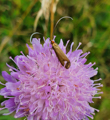2021 Annual Report for: Adelidae / Adelinae
For species seen in 2021 that had less than or equal to 100 records, full details are included; for more common species, the earliest, latest and highest count by vice-county are shown. The narrative for each species is taken from the main Hantsmoths website, and it is possible that some information on abundance and occurrence can get out of date, as it is impossible to keep up with all changes; however it should give a good introduction to each species. The tables in each species account summarise the previous status, and that for the current year.
For the maps, all records prior to 2021 are shown by a blue dot (the larger the dot, the more recent), with the current year's records shown in red. As previous records are superimposed on any report for 2021, new sites have greater emphasis (i.e. will show as 'more red').
In the species accounts, an asterisk next to a location indicates a new 10km square record; earliest ever dates are highlighted in orange, and latest ever in red. Initials in the species accounts refer to the recorders listed here. Please get in touch if you identify any omissions or errors, in particular if you have records that have yet to be submitted. Details of how to submit records can be found here.
07.001 [B&F: 0148] Nemophora degeerella (Linnaeus, 1758) - Common
Common in deciduous, often damp, woodland throughout England and Wales. Frequently recorded and well distributed across much of Hampshire and the Isle of Wight. Wingspan 17-23 mm. Unmistakable; male has very long antennae. Larva feeds on leaf litter, living within a movable case.
Records prior to 2021
| Vice County | #Records | #Individuals | First Record | Last Record |
|---|---|---|---|---|
| 10 | 96 | 403 | 1922 | 2020 |
| 11 | 344 | 853 | 1971 | 2020 |
| 12 | 285 | 1417 | 1974 | 2020 |
2021 records
| Vice County | #Records | #Individuals | Max Quantity |
|---|---|---|---|
| 10 | 4 | 5 | 3 |
| 11 | 8 | 20 | 10 |
| 12 | 15 | 20 | 3 |
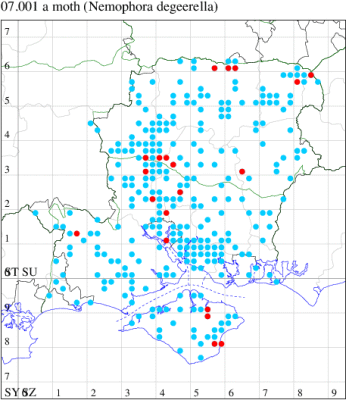
Records by year
Records by week (adult)
Records by week (larval)
Record Details
VC10: Combley Great Wood, one, 07 Jun (DFai); Shanklin, three, 10 Jun (IOut); , present, 12 Jun (KVin); Briddlesford, one, 09 Jun (JRB);
VC11: Frogham, three, field observation, three males, in dancing display, 12 Jun (NTO); Romsey, one, field observation, 02 Jun; one, 18 Jun (NRJ); Ashley, one, 26 Jun (GCE); Eastleigh, two, field observation, 04 Jun; 10, field observation, 15 Jun (AMur); Bitterne Park, Southampton, one, field observation, 07 Jun (NBur); Twyford, one, swept, 07 Jun (RJD);
VC12: Stockbridge Down NT, one, field observation, 26 Jun (MDuf); Little Somborne, one, 24 Jun; Crawley, one, 31 May; three, 14 Jun (GCE); Great Haughurst Copse, Axmansford, three, 10 Jun (ACB); Ropley, present, field observation, 13 Jun (TJN, LFom); Pamber Forest, one, 09 Jun; one, 02 Jun; one, 11 Jun; egg, two, 16 Jun; one, 24 Jun; one, field observation, 01 Jun (GJD); Minley Wood, two, field observation, 09 Jun; two, field observation, 10 Jun (BDal); Blackwater, present, field observation, 20 Jun (PBam)
07.002 [B&F: 0147] Nemophora metallica (Poda, 1761) - Nationally Scarce B
Nationally scarce (Nb) in dry pastures and chalk downland throughout much of south-eastern England. In Hampshire very local on the remaining downland in both vice-counties, most notably between Porton Down and Leckford. Not recorded from the Isle of Wight to date. Wingspan 15-20 mm. Larva feeds on seeds of Field Scabious and Small Scabious, subsequently feeding in the fallen leaves, living within a movable case.
Records prior to 2021
| Vice County | #Records | #Individuals | First Record | Last Record |
|---|---|---|---|---|
| 11 | 57 | 183 | 1920 | 2020 |
| 12 | 77 | 210 | 1958 | 2020 |
2021 records
| Vice County | #Records | #Individuals | Max Quantity |
|---|---|---|---|
| 12 | 10 | 22 | 6 |
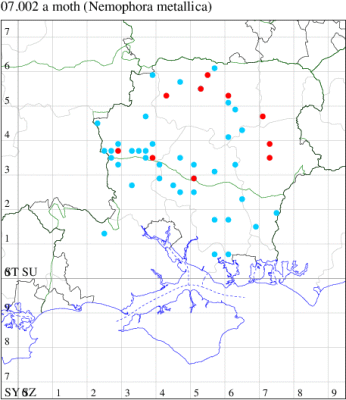
Records by year
Records by week (adult)
Records by week (larval)
Record Details
VC12: Middle Wallop, six, field observation, 23 Jul (PWal); Stockbridge Down, one, field observation, 01 Aug (CKni); St. Mary Bourne, two, field observation, 23 Jul (GRut); Magdalen Hill Down NR, one, field observation, 17 Jul (CKni); Overton, two, field observation, 20 Jul; Wolverton, two, field observation, 15 Jul (ACB); Worting Wood Farm, Basingstoke, five, field observation, 26 Jul (MJW); Alton, two, field observation, on Field Scabious in wildflower bed, 18 Jul; Upper Farringdon, one, field observation, on Scabious, 03 Aug (CJP det. CJP); South Warnborough, present, 01 Jul (E&PR)
07.006 [B&F: 0150] Adela reaumurella (Linnaeus, 1758) - Common
Common in woodland, heathland and fens throughout much of England, Wales and southern Scotland. In Hampshire and on the Isle of Wight often abundant in deciduous woodland, with the males often found swarming about the tips of branches of oak, sycamore and other deciduous trees. Wingspan 14-18 mm. Day-flying, males congregating in swarms in bright sunshine. Fairly unmistakable. Larva feeds on leaf litter, living within a movable case.
Records prior to 2021
| Vice County | #Records | #Individuals | First Record | Last Record |
|---|---|---|---|---|
| 10 | 182 | 2828 | 1977 | 2020 |
| 11 | 697 | 3764 | 1972 | 2020 |
| 12 | 309 | 9403 | 1971 | 2020 |
2021 records
| Vice County | #Records | #Individuals | Max Quantity |
|---|---|---|---|
| 10 | 12 | 12 | 5 |
| 11 | 5 | 5 | 2 |
| 12 | 7 | 13 | 6 |
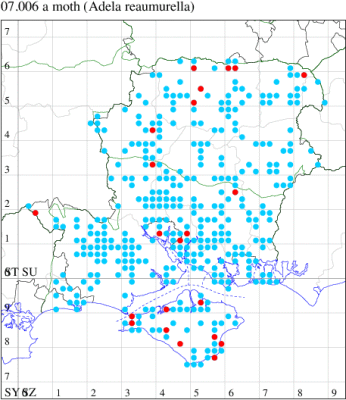
Records by year
Records by week (adult)
Records by week (larval)
Record Details
VC10: Totland Bay, one, field observation, 30 May (DCoo); Fort Victoria CP, present, field observation, 30 May (MCrm); Brighstone Down Chalk Pit, five, field observation, 25 Apr (JRB); Kingston, one, 17 May (ENes); Newtown, , present, 05 May (KVin); Bonchurch, one, 01 Jun; three, 02 Jun (JHa); Scotchells Brook, Shanklin, one, 15 Jun (IOut); Shanklin, , present, 11 May (KVin); Timber Copse & Great Mead Copse, present, field observation, 20 May; present, field observation, 22 May (VJB);
VC11: Winter Down Copse, Little Somborne, one, 02 Jun (GCE); Southampton Common, present, field observation, 27 May (iNat); Hightown, one, field observation, 01 Jun (DMall); Wildern LNR, Hedge End, one, field observation, 18 May (TCrw det. JHH); West Meon, two, 07 May (RJD, MLO, ADT, DWal);
VC12: Harewood Forest, one, field observation, 01 Jun (GCE); Stockbridge Down NT, present, field observation, 11 May (MDuf); Overton, six, field observation, 12 May (ACB); Ecchinswell, one, field observation, 17 May (MJN); Pamber Forest, one, 09 Jun; two, field observation, 01 Jun (GJD); Yateley Common, two, field observation, 08 May (BDal)
07.007 [B&F: 0149] Adela cuprella ([Denis & Schiffermüller], 1775) - Local
Local on heaths, fens and woodland in southern Britain, as far north as Sutherland. In Hampshire and the Isle of Wight very local in damp areas where Salix is plentiful, most notably in and around Pamber Forest. Wingspan 14-16 mm. Adult males have a hairy black head and long white antennae, which are quite visible with binoculars, as they fly often in small groups with their characteristic dancing flight over the tops of male Salix bushes. Females have shorter dark antennae with a yellowish/orange head and come lower down to lay on the catkins. Larva feeds on fallen leaves under Sallow, living within a movable case, over-wintering twice.
Records prior to 2021
| Vice County | #Records | #Individuals | First Record | Last Record |
|---|---|---|---|---|
| 10 | 15 | 33 | 1981 | 2014 |
| 11 | 53 | 379 | 1984 | 2020 |
| 12 | 31 | 338 | 1976 | 2020 |
2021 records
| Vice County | #Records | #Individuals | Max Quantity |
|---|---|---|---|
| 11 | 2 | 38 | 30 |
| 12 | 2 | 36 | 26 |
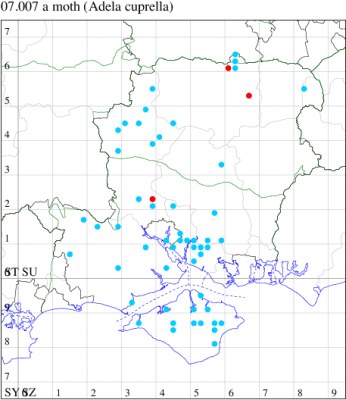
Records by year
Records by week (adult)
Records by week (larval)
Record Details
VC11: Romsey, eight, field observation, flying over sallow blossoms, 22 Mar; 30, field observation, flying over sallow blossoms at midday, 01 Apr (NRJ);
VC12: Mapledurwell Fen HIWWT, 10, field observation, 31 Mar; Pamber Forest, 26, field observation, swarming at sallow blossom, 30 Mar (GJD)
07.008 [B&F: 0151] Adela croesella (Scopoli, 1763) - Local
Local in woodland edges, downland, scrub and fens throughout much of England and Wales. In Hampshire and on the Isle of Wight very local, most often seen in daylight flying around hedgerows in suitable habitat in scattered locations across the county, although most common on the downland of central Hampshire south to Botley Wood, and west Wight; apparently absent from the New Forest. Wingspan 11-14 mm. The larva is primarily associated with the flowers and seeds of Wild Privet, subsequently feeding in the fallen leaves, living within a movable case.
Records prior to 2021
| Vice County | #Records | #Individuals | First Record | Last Record |
|---|---|---|---|---|
| 10 | 18 | 36 | 1900 | 2016 |
| 11 | 23 | 39 | 1974 | 2018 |
| 12 | 14 | 16 | 1996 | 2018 |
2021 records
| Vice County | #Records | #Individuals | Max Quantity |
|---|---|---|---|
| 12 | 1 | 1 | 1 |
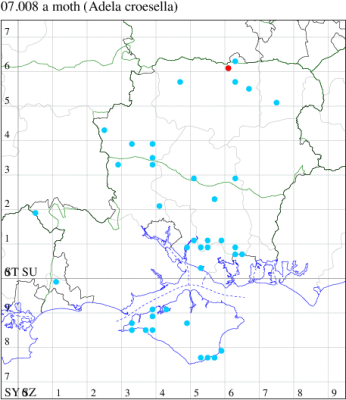
Records by year
Records by week (adult)
Records by week (larval)
Record Details
VC12: Pamber Forest, one, 09 Jun (GJD)
07.009 [B&F: 0153] Cauchas fibulella ([Denis & Schiffermüller], 1775) - Common
Common throughout much of Britain. In Hampshire fairly frequent throughout, with notable populations in Pamber Forest and Botley Wood; distinctly scarce on the Isle of Wight, where not recorded since 1979. Wingspan 8-11 mm. Larva feeds within seed capsules of Germander Speedwell, subsequently feeding on the leaves, living within a movable case.
Records prior to 2021
| Vice County | #Records | #Individuals | First Record | Last Record |
|---|---|---|---|---|
| 10 | 9 | 5 | 1900 | 2011 |
| 11 | 69 | 176 | 1972 | 2020 |
| 12 | 61 | 108 | 1971 | 2020 |
2021 records
| Vice County | #Records | #Individuals | Max Quantity |
|---|---|---|---|
| 12 | 7 | 32 | 12 |
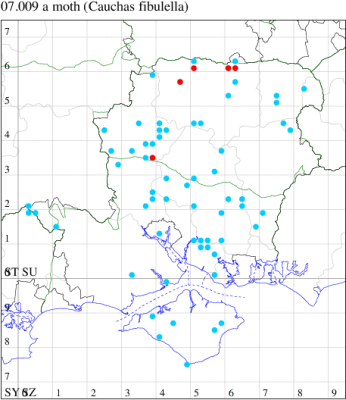
Records by year
Records by week (adult)
Records by week (larval)
Record Details
VC12: Stockbridge Down, 12, field observation, 05 Jun (DAS); Old Burghclere, six, field observation, 06 Jun (GJD); Ecchinswell, one, field observation, on Germander Speedwell, 30 May; six, field observation, on Germander Speedwell, 03 Jun; four, field observation, on Germander Speedwell, 11 Jun (MJN); Pamber Forest, one, netted, netted from Germander Speedwell flowers, 31 May; two, field observation, 01 Jun (GJD)
07.010 [B&F: 0152] Cauchas rufimitrella (Scopoli, 1763) - Common
Common in damp pastures, damp heathland and mosses throughout the British Isles, except for the far north. Wingspan 9-12 mm. Smaller than A. reaumurella. Day-flying in bright sunshine, sometimes in small, loose, low-flying swarms when conditions are favourable, but never in such large swarms as A. reaumurella; widely distributed across Hampshire and the Isle of Wight. Larva feeds within seedpods of Cuckoo-flower and Garlic Mustard, subsequently feeding on the leaves, living within a movable case, and over-wintering as a pupa.
Records prior to 2021
| Vice County | #Records | #Individuals | First Record | Last Record |
|---|---|---|---|---|
| 10 | 6 | 13 | 1981 | 2015 |
| 11 | 62 | 93 | 1972 | 2020 |
| 12 | 82 | 269 | 1971 | 2020 |
2021 records
| Vice County | #Records | #Individuals | Max Quantity |
|---|---|---|---|
| 11 | 3 | 6 | 5 |
| 12 | 1 | 1 | 1 |
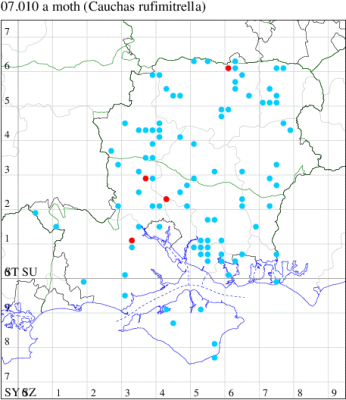
Records by year
Records by week (adult)
Records by week (larval)
Record Details
VC11: Woodlands, NF, present, 24 May (RBW); Humbers Wood, Kings Somborne, five, field observation, 14 May (A&LB); Hocombe Mead LNR, Chandlers Ford, one, field observation, 30 May (AMur det. BDal);
VC12: Pamber Forest, one, field observation, 27 May (GJD)
07.012 [B&F: 0141] Nematopogon schwarziellus Zeller, 1839 - Common
Common in deciduous woodland, hedgerows, heathland and moorland throughout the British Isles. Widespread and often fairly common throughout Hampshire and on the Isle of Wight. Wingspan 14-17 mm. Resembles N. swammerdamella, with long white antennae and yellow-orange head tufts, but smaller and with hint of a discal spot; flies later in the year (MBGBI Vol 1). Larva feeds on dead leaves, living within a movable case, over-wintering twice.
Records prior to 2021
| Vice County | #Records | #Individuals | First Record | Last Record |
|---|---|---|---|---|
| 10 | 69 | 114 | 1900 | 2019 |
| 11 | 239 | 319 | 1972 | 2020 |
| 12 | 131 | 200 | 1975 | 2020 |
2021 records
| Vice County | #Records | #Individuals | Max Quantity |
|---|---|---|---|
| 10 | 2 | 2 | 1 |
| 11 | 6 | 5 | 1 |
| 12 | 9 | 9 | 1 |
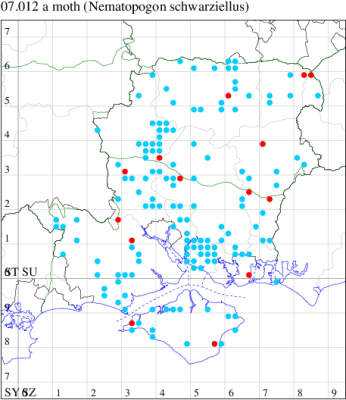
Records by year
Records by week (adult)
Records by week (larval)
Record Details
VC10: Freshwater, one, 26 Jun (DCoo); Shanklin, one, 10 Jun (IOut);
VC11: Woodlands, NF, present, 12 Jun (RBW); Broughton, one, 08 Jul (GCE); Winchester, one, 11 Jun (THW); Portsmouth, one, 15 Jun (IRT); Petersfield, one, 15 Jun; one, 16 Jun (RAll);
VC12: Little Somborne, one, 24 Jun (GCE); Old Basing, Basingstoke, one, 20 Jun (SVic); Basingstoke, one, 06 Jun; one, 12 Jun (MJW); Alton, one, to artificial light, 17 Jun (DBO); Yateley Common, one, field observation, 25 May; Blackwater, one, 18 May; one, field observation, 20 May; one, 05 Jun (BDal)
07.014 [B&F: 0143] Nematopogon metaxella (Hübner, [1813]) - Local
Local in woodland, fens, marshes and bogs throughout much of England and Wales. In Hampshire and on the Isle of Wight there are scattered records from all three vice-counties. Wingspan 15-17 mm. This species may be confused with N. schwarziellus or N. pilella, but may be recognised by its more rounded wings and more prominent dark mark at the end of the cell of the forewing (MBGBI Vol 1). Larva feeds on dead leaves, living within a movable case.
Records prior to 2021
| Vice County | #Records | #Individuals | First Record | Last Record |
|---|---|---|---|---|
| 10 | 32 | 44 | 1900 | 2020 |
| 11 | 227 | 306 | 1974 | 2020 |
| 12 | 78 | 117 | 1980 | 2020 |
2021 records
| Vice County | #Records | #Individuals | Max Quantity |
|---|---|---|---|
| 10 | 9 | 13 | 3 |
| 11 | 19 | 21 | 2 |
| 12 | 3 | 6 | 2 |
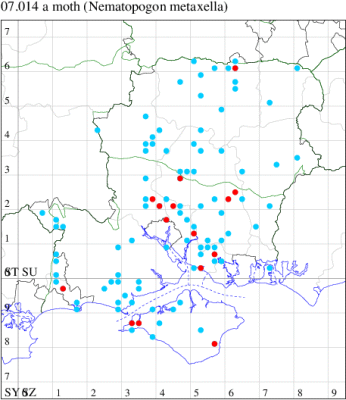
Records by year
Records by week (adult)
Records by week (larval)
Record Details
VC10: Totland, two, 19 Jun; three, 22 Jun; one, 26 Jun (RTer); Freshwater, one, 27 Jun; one, 06 Jul; one, 26 Jun (PBar); Shanklin, two, 13 Jun; one, 16 Jun; one, 29 Jun (IOut);
VC11: Romsey, one, 18 Jun; one, 19 Jun (NRJ); Swaythling, Southampton, one, 13 Jun; one, 20 Jun (MEdg); Barn Piece, Eastleigh, one, 18 Jun (KArb); Allbrook, one, 10 Jun (SIng); Winchester, one, 30 Jun (THW); Titchfield Haven NNR, one, 25 Jun (RJD, DWal, KJW, RCar, DHun); Fareham, one, 12 Jun (MLO); Botley, one, 11 Jun; one, 15 Jun; one, 11 Jun; two, 12 Jun; two, 21 Jun (SLB); Wickham, one, 08 Jul (JRDS); Beacon Hill NNR, Warnford, one, field observation, 22 May (DHub); West Meon, one, gen det, 02 Jul (RJD, MLO, ADT, DWal, KJW det. RJD); Hurn, one, 03 Jun; one, 27 Jun (MJef);
VC12: Pamber Forest, two, 11 Jun; two, 24 Jun; two, 28 Jun (GJD)
07.015 [B&F: 0140] Nematopogon swammerdamella (Linnaeus, 1758) - Common
Common in deciduous woodland throughout the British Isles. Widespread and often fairly common throughout Hampshire and on the Isle of Wight. Wingspan 17-21 mm. Resembles N. schwarziellus, with long white antennae and yellow-orange head tufts, but larger and with no discal spot; flies earlier in the year (MBGBI Vol 1). Larva feeds on dead leaves, living within a flat, movable case on the ground, and over-wintering twice.
Records prior to 2021
| Vice County | #Records | #Individuals | First Record | Last Record |
|---|---|---|---|---|
| 10 | 96 | 163 | 1963 | 2020 |
| 11 | 470 | 521 | 1972 | 2020 |
| 12 | 181 | 228 | 1971 | 2020 |
2021 records
| Vice County | #Records | #Individuals | Max Quantity |
|---|---|---|---|
| 10 | 20 | 33 | 5 |
| 11 | 24 | 25 | 2 |
| 12 | 20 | 20 | 2 |
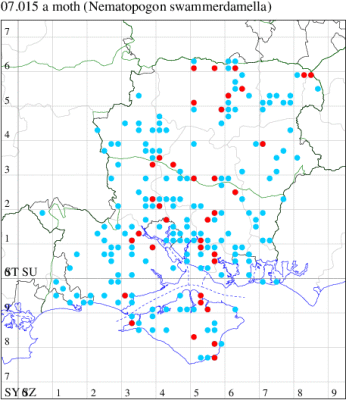
Records by year
Records by week (adult)
Records by week (larval)
Record Details
VC10: Totland Bay, two, field observation, 30 May (DCoo); Totland, one, field observation, 27 May; one, 01 Jun (RTer); Bonchurch, one, 08 May; one, 17 May; one, 18 May; two, 07 Jun; two, 10 Jun; five, 11 Jun (JHa); Rookley, one, 25 Jun (JRB); Shanklin, one, 27 May; one, 08 Jun; three, 10 Jun; two, 16 Jun; two, 23 Jun; one, 29 Jun (IOut); Timber Copse & Great Mead Copse, present, field observation, 22 May (VJB); Osborne Valley Walk, three, 01 Jun; two, 15 Jun (IOut); Briddlesford, one, 09 Jun (JRB);
VC11: Marchwood, two, 12 Jun; one, 14 Jun; one, 14 Jun; one, 20 Jun (CTha); Woodlands, NF, present, 01 Jun (RBW); Ashurst, NF, two, 12 Jun (SAB); Totton, one, 15 Jun (LHan); Romsey, one, 27 Apr; one, 27 May (NRJ); Winter Down Copse, Little Somborne, one, 09 May (GCE); Swaythling, Southampton, one, 28 May (MEdg); Barn Piece, Eastleigh, one, 22 May (KArb); Botley Wood, one, field observation, 22 May (DWal); Fareham, one, 01 Jun; one, 08 Jun (IMcP); one, 13 Jun (MLO); Botley Wood, Whiteley Pastures, one, field observation, 25 May; one, field observation, 25 May; one, field observation, 12 May; one, field observation, 01 Jun (SAC); Bishop's Waltham, present, field observation, 31 May (DTru); Hilltop, The Hangers, two, 12 Jun (SIng det. DPH); West Meon, one, 07 May (RJD, MLO, ADT, DWal); Pennington, one, 06 Jun (RFC);
VC12: Little Somborne, one, 28 May; Crawley, one, 28 May; one, 14 Jun (GCE); Morn Hill, Winchester, one, 12 Jun (CBey, DAS, PDF et al); present, 12 Jun; Cheriton, one, field observation, 25 May (DAS); Basingstoke, one, 01 Jun (GAH); Stockbridge Down NT, one, field observation, 11 May (MDuf); Ecchinswell, one, field observation, 27 May; one, field observation, 08 Jun; one, 13 Jun (MJN); Great Haughurst Copse, Axmansford, one, 10 Jun (ACB); Basingstoke, one, 14 Jun (MJW); Basing Forest, one, field observation, 06 May (MDuf); Pamber Forest, one, 24 Jun (GJD); Alton, one, 01 Jun (DBO); Yateley Common, one, field observation, 22 May; one, field observation, 25 May; two, field observation, 26 May; Blackwater, one, 22 May (BDal)
